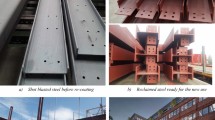Abstract
The number of studies on the environmental impact of products and services has increased in order to protect the environment. Recently, environmental impact assessments (EIA) and life cycle assessments (LCA), typically used for evaluating environmental impacts, have been gaining in popularity. Accordingly, this study performed an EIA using LCA methodology focusing on the manufacture of composite small craft. A work breakdown structure (WBS) is used in most shipyards to manage the overall life cycle of a craft. Therefore, for the EIA performed as part of this study, the generic WBS for environment (GWBSE) was defined by utilizing existing shipyard information. Unlike a general WBS with a determined structure, the GWBSE structure supports different combinations depending on the objectives; the EIA can be performed by combining different methods, materials, and product structures used in the manufacturing process for composite craft. Further, this study developed an application to effectively perform EIA utilizing GWBSE. The EIA was performed according to the manufacturing method and the combination of materials used for small leisure craft; the results were then analyzed.
Similar content being viewed by others
Abbreviations
- i:
-
Index of generic object
- j:
-
Index of manufacturing process
- k:
-
Index of material choice
- l:
-
Index of environmental indicator
- I:
-
Total number of generic objects
- L:
-
Total number of environmental indicators
- EI jk :
-
Environmental impact value of the target product against to the manufacturing process j and material k
- p ijkl :
-
Environmental impact score of generic object i, manufacturing process j, material choice k, environmental indicator l
- w l :
-
Weighted value of environmental indicator l
- r i :
-
Proportion ratio of generic object i
References
Yun, J.-H., Jeong, M.-S., Lee, S.-K., Jeon, J.-W., Park, J.-Y., et al., “Sustainable Production of Helical Pinion Gears: Environmental Effects and Product Quality,” Int. J. Precis. Eng. Manuf.-Green Tech., Vol. 1, No. 1, pp. 37–41, 2014.
Meng, Q., Li, F.-Y., Zhou, L.-R., Li, J., Ji, Q.-Q., et al., “A Rapid Life Cycle Assessment Method Based on Green Features in Supporting Conceptual Design,” Int. J. Precis. Eng. Manuf.-Green Tech., Vol. 2, No. 2, pp. 189–196, 2015.
Hayman, B., Dogliani, M., Kvale, I., and Fet, A. M., “Technologies for Reduced Environmental Impact from Ships-Ship Building, Maintenance and Dismantling Aspects,” 2000.
Tincelin, T., Mermier, L., Pierson, Y., Pelerin, E., and Jouanne, G., “A Life Cycle Approach to Shipbuilding and Ship Operation,” Proc. of the International Conference on Ship Design and Operation for Environmental Sustainability, 2010.
Rebitzer, G., Ekvall, T., Frischknecht, R., Hunkeler, D., Norris, G., et al., “Life Cycle Assessment: Part 1: Framework, Goal and Scope Definition, Inventory Analysis, and Applications,” Environment International, Vol. 30, No. 5, pp. 701–720, 2004.
Vogtländer, J. G., Lindeijer, E., Witte, J. P. M., and Hendriks, C., “Characterizing the Change of Land-Use Based on Flora: Application for EIA and LCA,” Journal of Cleaner Production, Vol. 12, No. 1, pp. 47–57, 2004.
Li, X., Zhu, Y., and Zhang, Z., “An LCA-Based Environmental Impact Assessment Model for Construction Processes,” Building and Environment, Vol. 45, No. 3, pp. 766–775, 2010.
Glasson, J., Therivel, R., and Chadwick, A., “Introduction to Environmental Impact Assessment,” Routledge, 4th Ed., pp. 14–15, 2012.
Tukker, A., “Life Cycle Assessment as a Tool in Environmental Impact Assessment,” Environmental Impact Assessment Review, Vol. 20, No. 4, pp. 435–456, 2000.
Finnveden, G. and Moberg, Å., “Environmental Systems Analysis Tools-an Overview,” Journal of Cleaner Production, Vol. 13, No. 12, pp. 1165–1173, 2005.
Manuilova, A., Suebsiri, J., and Wilson, M., “Should Life Cycle Assessment be Part of the Environmental Impact Assessment? Case Study: EIA of CO2 Capture and Storage in Canada,” Energy Procedia, Vol. 1, No. 1, pp. 4511–4518, 2009.
Olofsson, K., Arnestad, G., Lönnö, A., Hedlund-Åström, A., Jansson, T., et al., “A High-Speed Craft with Composite Hull,” Proc. of the 13th European Conference of Composite Materials, 2008.
Okayama, Y. and Chirillo, L. D., “Product Work Breakdown Structure,” National Shipbuilding Research Program, Vol. 117, Washington, D.C.: US Department of Commerce, Maritime Administration in Cooperation with Todd Pacific Shipyards Corporation, 1980.
Lee, D. K., Nam, S. H., Jeong, Y.-K., and Shin, J.-G., “Development of a Generic-YWBS for Engineering Integrated Management of Sailing Yacht,” Journal of the Society of Naval Architects of Korea, Vol. 51, No. 1. pp. 16–25, 2014.
Koenig, P. C., MacDonald, P., Lamb, T., and Dougherty, J., “Towards a Generic Product-Oriented Work Breakdown Structure for Shipbuilding,” The Society of Naval Architects and Marine Engineers, pp. 21–23, 1997.
Rebitzer, G., Ekvall, T., Frischknecht, R., Hunkeler, D., Norris, G., et al., “Life Cycle Assessment Part 1: Framework, Goal and Scope Definition, Inventory Analysis, and Applications,” Environmental International, Vol. 30, No. 5, pp. 701–720, 2004.
Anderson, J., Jansz, A., Steele, K., Thislethwaie., P., Bishop, G., et al., “Green Guide to Composites: An Environmental Profiling System for Composite Materials and Products,” REB Press, 1st Ed., pp. 1–35, 2004.
Jeong, Y.-K., Lee, P., Nam, S. H., Lee, D. K., and Shin, J.-G., “Development of the Methodology for Environmental Impact of Composite Boats Manufacturing Process,” Procedia CIRP, Vol. 29, pp. 456–461, 2015.
Author information
Authors and Affiliations
Corresponding author
Additional information
An erratum to this article can be found at http://dx.doi.org/10.1007/s40684-016-0050-2.
Rights and permissions
About this article
Cite this article
Nam, S., Lee, D.K., Jeong, YK. et al. Environmental impact assessment of composite small craft manufacturing using the generic work breakdown structure. Int. J. of Precis. Eng. and Manuf.-Green Tech. 3, 261–272 (2016). https://doi.org/10.1007/s40684-016-0034-2
Received:
Revised:
Accepted:
Published:
Issue Date:
DOI: https://doi.org/10.1007/s40684-016-0034-2




